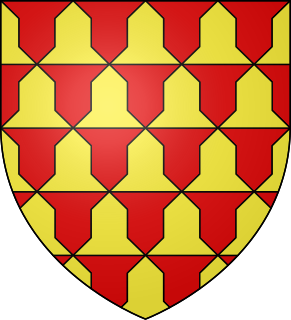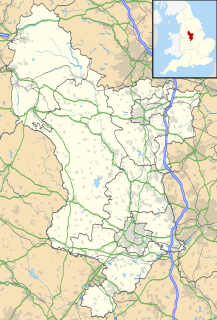
Earl of Derby is a title in the Peerage of England. The title was first adopted by Robert de Ferrers, 1st Earl of Derby, under a creation of 1139. It continued with the Ferrers family until the 6th Earl forfeited his property toward the end of the reign of Henry III and died in 1279. Most of the Ferrers property and, by a creation in 1337, the Derby title, were then held by the family of Henry III. The title merged in the Crown upon Henry IV's accession to the throne.

Tutbury is a large village and civil parish of about 3,076 residents in the English county of Staffordshire.

The title Baron Ferrers of Chartley was created on 6 February 1299 for John de Ferrers, son of Robert de Ferrers, 6th Earl of Derby. The daughter of the 6th Baron Ferrers of Chartley, Anne, married Walter Devereux who was summoned to parliament as Lord Ferrers in her right. Their descendants became Earls of Essex and so the peerage was also forfeited from 1601 to 1604. After the restoration to the title, the 12th Baron died and the peerage fell into abeyance in 1646. The abeyance was terminated in 1677 in favour of Robert Shirley. In 1711 he was created the 1st Earl Ferrers. On the death of his granddaughter, the wife of the 5th Earl of Northampton, the peerage fell into abeyance again. When only one of the three daughters of the 14th Baroness Ferrers of Chartley remained, the abeyance of the barony terminated for this daughter, who was the wife of the 1st Marquess Townshend. The barony remained still merged with the marquessate until the death of the 3rd Marquess, when it again fell into abeyance between the marquess's two sisters and their heirs.
William de Wendenal was a Norman baron probably born during the mid-12th century. He was one of the highest officials left in charge of the Kingdom of England when King Richard the Lionheart was away at the Third Crusade to reclaim the Holy Land from the control of Saladin of the Ayyubid dynasty.

Henry de Ferrers, magnate and administrator, was a Norman who after the 1066 Norman conquest was awarded extensive lands in England.
William I de Ferrers, 3rd Earl of Derby was a 12th-century English Earl who resided in Tutbury Castle in Staffordshire and was head of a family which controlled a large part of Derbyshire known as Duffield Frith. He was also a Knight Templar.
Walchelin was a Norman name, which may refer to:
William II de Ferrers, 4th Earl of Derby, was a favourite of King John of England. He succeeded to the estate upon the death of his father, William de Ferrers, 3rd Earl of Derby, at the Siege of Acre in 1190. He was head of a family which controlled a large part of Derbyshire which included an area known as Duffield Frith.
Walter de Clifford (1113–1190) was an Anglo-Norman Marcher Lord of Bronllys Castle on the Welsh border, and was feudal baron of Clifford, seated at Clifford Castle in Herefordshire.
Henry Cantrell was a high-church Church of England clergyman and religious controversialist.

Holbrook is a village in Derbyshire at the southern end of the Pennines around five miles north of Derby, England. The population of the civil parish as of the 2011 census was 1,538.
Walkelin de Ferrers may refer to:

Robert de Ferrers, 6th Earl of Derby (1239–1279) was an English nobleman.

Markeaton Hall was an 18th-century country house at Markeaton, Derby, Derbyshire.

Croxall Hall is a restored and extended 16th century manor house situated in the small village of Croxall, Staffordshire. It is a Grade II* listed building.

Sir Simon Degge (1612–1703) was born in Staffordshire but settled in Derby. He became a High Sheriff of Derbyshire and served North Wales as a Justice.. It was said that he served his year as Sheriff in "barrister robes and with a sword by his side". Degge was a Royalist and wrote a reference book on the law and rights of a parson called the Parson's Counsellor.... The book includes advice on the income from a glebe, Jus patronatus and the crime of Simony.

Thomas Gladwin (fl.1668) of Tupton Hall, in the parish of Wingerworth near Chesterfield, Derbyshire, was Sheriff of Derbyshire in 1668.















